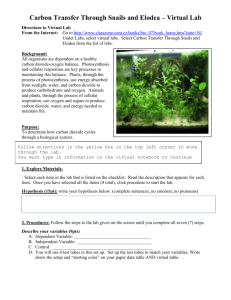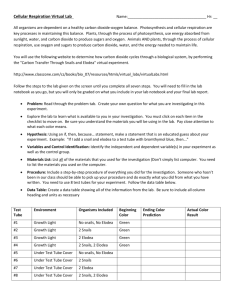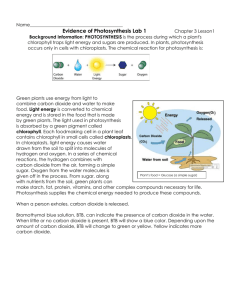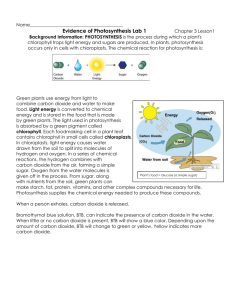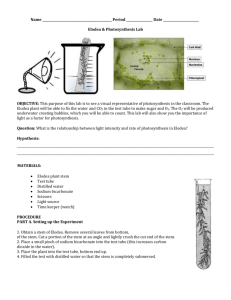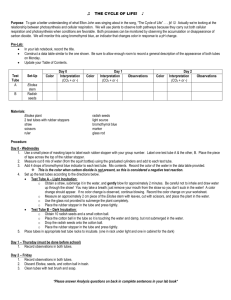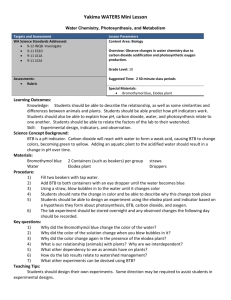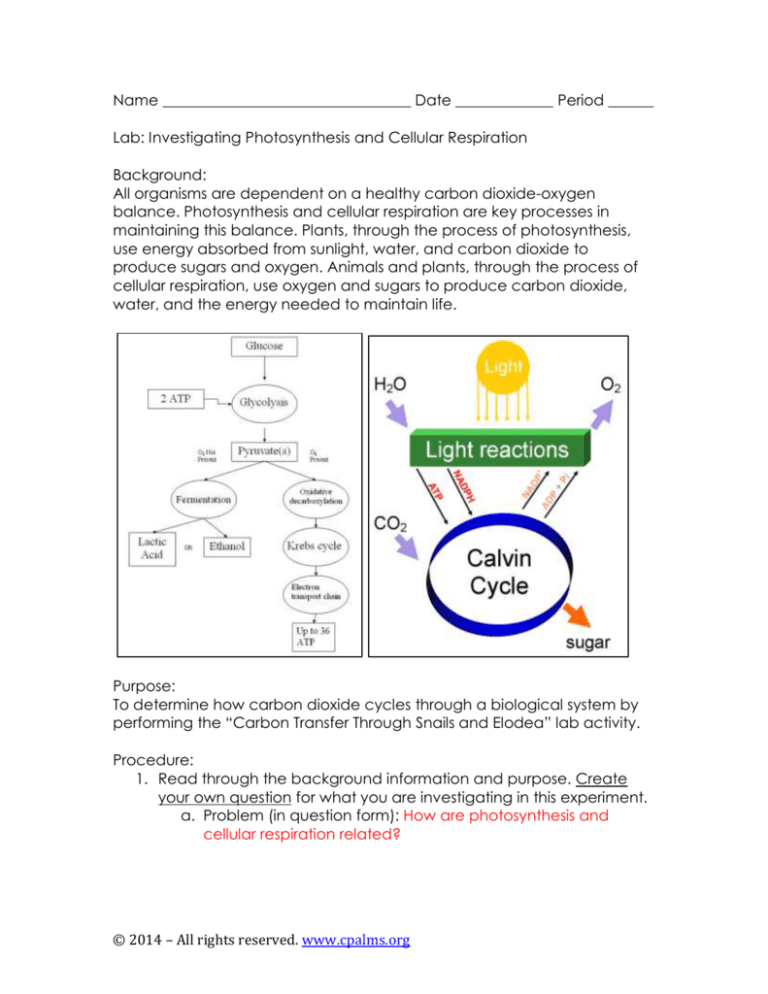
Name _________________________________ Date _____________ Period ______
Lab: Investigating Photosynthesis and Cellular Respiration
Background:
All organisms are dependent on a healthy carbon dioxide-oxygen
balance. Photosynthesis and cellular respiration are key processes in
maintaining this balance. Plants, through the process of photosynthesis,
use energy absorbed from sunlight, water, and carbon dioxide to
produce sugars and oxygen. Animals and plants, through the process of
cellular respiration, use oxygen and sugars to produce carbon dioxide,
water, and the energy needed to maintain life.
Purpose:
To determine how carbon dioxide cycles through a biological system by
performing the “Carbon Transfer Through Snails and Elodea” lab activity.
Procedure:
1. Read through the background information and purpose. Create
your own question for what you are investigating in this experiment.
a. Problem (in question form): How are photosynthesis and
cellular respiration related?
© 2014 – All rights reserved. www.cpalms.org
2. Obtain 8 test tubes of equal size/volume and number the test tubes
1-8. Fill each test tube with approximately 30 mL of deionized water.
3. Add enough bromothymol blue (BTB) indicator to solution to each
test tube to change the water to a green color (about 3 mL).
4. What is Bromothymol Blue? Why is the BTB in the test tube green
(Hint: recall the teacher demonstration)?
Bromothymol blue is an indicator that changes color when carbon
dioxide is present. Green in the test tube means a low carbon
dioxide presence.
5. If snails use lungs to breathe, you can conclude that they release
which gas into their environment as a result of respiration?
Carbon Dioxide
6. If Elodea is an aquatic plant, you can conclude that it releases
which gas into its environment as a result of photosynthesis?
Oxygen
7. Next, place the following items in each appropriately labeled test
tube.
Test Tube Number
Added Contents
#1 and #5
Water Only
#2 and #6
2 snails
#3 and #7
2 sprigs of Elodea
#4 and #8
2 snails and 2 sprigs of Elodea
8. Place test tubes 1-4 in a test tube rack and place the rack under a
growth light.
9. What is the purpose of the growth light?
To synthesize sunlight for the plants
10. Place test tubes 5-8 in a test tube rack and place the rack under a
test tube rack cover.
11. What is the purpose of the test tube rack cover?
To provide dark conditions
© 2014 – All rights reserved. www.cpalms.org
12. Make your predictions below:
Test
Conditions Contents of Predict Color and Explain
Tube
Tube
#
Light
Water only Answers will vary
1
Light
2 snails
Answers will vary
2
Light
2 Elodea
Answers will vary
3
Light
2 snails and Answers will vary
4
2 Elodea
Dark
Water only Answers will vary
5
Dark
2 snails
Answers will vary
6
Dark
2 Elodea
Answers will vary
7
Dark
2 snails and Answers will vary
8
2 Elodea
Predict - Explain how carbon dioxide (CO2) cycles in aquarium water
through snails and Elodea. Complete the following statement to develop
your own hypothesis.
If I add a snail and elodea to a test tube with bromothymol blue,
then the water will turn yellow in light conditions and/or dark
conditions.
Explain: Why do you think this outcome will occur?
Snails will produce only carbon dioxide, while the Elodea will
produce carbon dioxide and oxygen gas. I predict the snails and
Elodea will produce more carbon dioxide, causing the water to turn
yellow.
Read This:
The independent variable in an experiment is the variable that will be
altered by you, the scientist. In the case of this experiment, the
independent variable will be the number of snails and/or number of
elodea plants in each test tube.
1. Identify the dependent variable (what you, the scientist, will
measure) in this experiment: change in carbon dioxide levels (using
the BTB indicator)
Now you must wait 24 hours. (make sure you clean up your station!)
© 2014 – All rights reserved. www.cpalms.org
Data/Results:
Yesterday, you filled 8 test tubes with the following contents. Carefully
remove your test tube racks from the light or dark conditions and
complete the tables below with your observations.
First Test Tube Rack – Placed under the growth light:
Test Tube
Independent
Beginning
Color
with BTB
Variables
Color
Prediction
Tube # 1
Water Only
Green
Varies
Tube #2
2 snails
Green
Varies
Tube #3
2 Elodea
Green
Varies
Tube #4
2 snails, 2 Elodea
Green
Varies
Second Test Tube Rack – Placed under the test tube cover:
Test Tube
Independent
Beginning
Color
with BTB
Variables
Color
Prediction
Tube # 1
Water Only
Green
Varies
Tube #2
2 snails
Green
Varies
Tube #3
2 Elodea
Green
Varies
Tube #4
2 snails, 2 Elodea
Green
Varies
Color Result
Green
Yellow
Green
Yellow
Color Result
Green
Yellow
Yellow
Yellow
Conclusions:
Complete the following sentences.
1. In the test tubes which contained only snails, the water changed to
yellow because the snails produced lots of carbon dioxide.
2. In the test tubes which contained only Elodea under the light, the
water stayed green because the Elodea performed both
photosynthesis and cellular respiration and produced oxygen and
carbon dioxide.
3. In the test tubes which contained only Elodea in the dark, the water
changed to yellow because the Elodea performed cellular
respiration and produced lots of carbon dioxide.
4. In the test tubes which contained both snails and Elodea under the
light, the water changed to yellow because the snails and Elodea
produced more carbon dioxide.
© 2014 – All rights reserved. www.cpalms.org
Extension:
1. Conclude. What is the relationship between snails and Elodea?
The snails perform only cellular respiration, while the Elodea perform both
photosynthesis and cellular respiration.
2. Analyze. Why did the color of the Bromthymol Blue (BTB) solution
change in certain test tubes?
The levels of carbon dioxide changed, therefore the BTB solution changed
color to indicate the presence of carbon dioxide.
3. Analyze. What was the importance of a control in your experiment?
What would you conclude if the color of the solution in the control
changed?
The control allowed me to have a point of reference in which no change
should have occurred. If the control solution changed color, I would
conclude there were organisms in the water.
4. Infer. When you began the experiment, was there CO2 in the water? In
the test tubes that contained Elodea, where did the CO2 go?
Yes, the water was green. This indicates a low level of carbon dioxide. In
the tubes that contained Elodea, the carbon dioxide was used in the
photosynthesis process.
5. Infer. Which gas did the snails release? What observation supports this
inference?
The snails released both oxygen and carbon dioxide. This was indicated
by the solution changing to yellow.
© 2014 – All rights reserved. www.cpalms.org
6. Apply. Based on the results of your experiment, explain why you need to
add the Elodea to your snail aquarium.
Adding the Elodea creates a symbiotic environment in which the snails
can obtain oxygen from the Elodea.
7. Assess.
Write the balanced chemical equation for photosynthesis below (label
reactants and products).
Reactants
Products
6 CO2 + 6 H2O + Sunlight (energy) C6H12O6 + 6 O2
Write the balanced chemical equation for cellular respiration below (label
reactants and products).
Reactants
Products
C6H12O6 + 6 O2 6 CO2 + 6 H2O + ATP (energy)
Draw a diagram below of your results:
Answers will vary. Diagrams should include drawings of the experiment
setup and labels of what processes are happening in each area. (i.e.
label snails and Elodea, include products and reactants of each process.)
© 2014 – All rights reserved. www.cpalms.org

